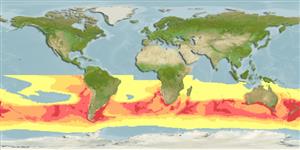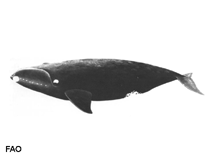Eubalaena australis (Desmoulins, 1822)
Southern right whale| Native range | All suitable habitat | Point map | Year 2050 |

|
| This map was computer-generated and has not yet been reviewed. |
| Eubalaena australis AquaMaps Data sources: GBIF OBIS |
Классификация / Names народные названия | синонимы | CoL | ITIS | WoRMS
Mammalia | Cetartiodactyla | Balaenidae
Environment: milieu / climate zone / пределы глубины / distribution range экология
пелагический. Tropical; 0°N - 90°S, 180°W - 180°E
Distribution страны | регионы FAO | Ecosystems | места находок | интродукции
Southern hemisphere: Antarctic to temperate waters; occasionally along the northern part of the Antarctic Peninsula. [Chile-Peru population: IUCN 2010 (Ref. 84930): CR, D.]
Length at first maturity / Size / Weight / Возраст
половая зрелость: Lm ? range ? - ? cm Max length : 1,700 cm TL самец/пол неопределен; (ссылка 1394); наибольший вес (опубликованные данные): 100.0 t (ссылка 1394)
Life cycle and mating behavior половая зрелость | размножение | нерест | Eggs | Fecundity | Larvae
Основная ссылка
ссылки | координатор | соавторы
Jefferson, T.A., S. Leatherwood and M.A. Webber 1993 FAO species Identification Guide: Marine Mammals of the World. Rome, FAO. 320 p. + 587 figures. (ссылка 1394)
Статус Красного Списка МСОП
(ссылка 130435: Version 2025-1)
Статус СИТЕС (ссылка 108899)
CMS (ссылка 116361)
Угроза для людей
Использование человеком
рыболовство: коммерческий
FAO - рыболовство: landings, Видовой профиль | FishSource | Sea Around Us
инструменты
дополнительная информация
состав пищи
потребление пищи
хищники
ресурсы в Интернет
BHL | BOLD Systems | CISTI | DiscoverLife | FAO(рыболовство: Видовой профиль; publication : search) | Fishipedia | GenBank (Геном, Нуклеотид) | GloBI | Gomexsi | Google Books | Google Scholar | Google | PubMed | Tree of Life | Wikipedia (Вперёд, поиск) | Zoological Record



